A maths problem is a maths problem – if it was written last year, 10 years ago or 20 years ago.
Obviously you would not want to follow the progression of an old maths scheme or use dated pupil material but there will be some great ideas, especially within the teachers’ books.
The old numeracy framework and Primary Strategy documents are really good examples of this; there are some valuable reference books amongst all the material produced. If you are teaching a specific maths objective with clear expected outcomes then it may be worth taking a look for examples of questions and activities from the framework document. The maths objective may no longer be in the same year, but may still be covered.
Be careful, too, about throwing out maths resources that you feel may no longer be used – those wipe clean laminated sheets for recording grid multiplication, for example. The PoS emphasise a return to a single ‘efficient’ written calculation method. So does this mean you no longer teach the grid method and just concentrate on a formal column method?
This is where there may be a lack of detail in curriculum planning, picking out the small steps of progression within a maths strand. I would suggest that the grid method is an important stage of moving children towards a long multiplication column method. It gives children a real understanding of the place value of each digit that will remain with them when going on to the column method, so they are less likely to make basic errors related to place value.
When discussing this with teachers to clarify the methods it was very useful to ask, 'What's the same and what's different?' about the two methods. Highlighting similarities and differences with your class will show how the two methods naturally work together.
It is worth looking at the NCETM video of a teacher using this very effectively with her class: Moving from grid to a column method.
As teachers we are constantly striving to develop our teaching methods and pedagogical subject knowledge to help children learn. We are also always on the look out for creative ideas and approaches to engage children. Old maths books do have these ideas, written by authors that want to support and inspire. So have a good look in the backs of cupboards or if you’re idly browsing in second hand book shops over the summer, take a look in the education sections and see what you can find.
These are five of my favourite old maths books and resources that I still reference:
• Mathematics through art & design 6-13
Anne Woodman & Eric Albany
• Bounce to it / Leap to it/ Jump to it ( three booklets)
Gillian Hatch
• Thinking Mathematically
John Mason
• Primary Mathematics Today
Williams and Shuard
• Measuring up
Peter Patilla
And five of mine that are now out of print
but full of strong maths ideas:
• Longman Primary Maths Teacher's Handbooks (Longman books for R-Y6)
Peter Patilla, Ann Montague-Smith and Paul Broadbent
• Maths Plus Number and the Number System (Heinemann Series for Y1-Y6)
Paul Broadbent and Kathryn Church
• Targeting Number (Longman Series for KS2/3)
Paul Broadbent and Rob Kearsley Bullen
• Maths Match (Harcourt Series for Y4-Y6)
Paul Broadbent, Len Frobisher, Jeanette Mumford, Allison Toogood
• Maths Weekly Workout (Letts Series for Y3-Y6)
Paul Broadbent and Peter Patilla
Take a look at this earlier article on the National Stem Centre e-Library - they provide some free pdfs of old (and some current) maths books.




